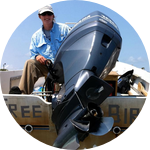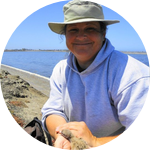About This Project
The Amazon Basin of South America is a vast area covering about 7.5 million square kilometers that relies on a flood-pulse system where the rivers flood annually. How Amazon waterbirds respond to the flood-pulse system is relatively unknown. Some birds may move north to unflooded locations while other species seem to just disappear for the wet season. My project proposes to follow the movements of the Black Skimmer and the Large-billed Tern to see how they respond to river flooding.
Ask the Scientists
Join The DiscussionWhat is the context of this research?
Waterbird movements within tropical systems are greatly under researched, yet this information is critical to understanding the ecology of the systems that these birds belong to. The Amazon Basin of South America is one of the most diverse places in the world, and one of the reasons for this biodiversity is the cyclic nature of flooding and localized precipitation pattern. When the wet season starts and rivers begin to flood, waterbirds that use the dry season for reproduction just seem to disappear. Where they go is not known, although some do cross the Andes Mountain range (Davenport et al. 2016) while others may simply fly north or east into parts of the basin not yet flooded.
What is the significance of this project?
Hydroelectric dam systems are being developed with the potential to disturb the hydrological regime of the Amazon Basin (Finer et al. 2012). Waterbirds that are reliant upon the Amazon for a part or most of their lifecycle are at risk, yet movements and habitat requirements of these waterbirds are relatively unknown. This gap in our knowledge limits our ability to understand emerging threats and how waterbirds may respond to changes in hydrology in the Amazon Basin, and it limits our ability to manage and conserve migratory waterbirds within the existing system of protected natural areas.
What are the goals of the project?
The goal of this research is to explore the relationship between hydrology, food resources, and waterbird movements in the Peruvian Amazon. The Rio Madre de Dios was chosen as this is the location for planned hydroelectric development. To complete this effort, this project will document movements of waterbirds within areas of the Rio Manu and Rio Madre de Dios- answering the question of where waterbirds go during the wet season in the Peruvian portion of the Amazon. We will also measure food resources, river characteristics, and microhabitat variables to determine what characteristics best relate to nesting success for targeted waterbird species. We anticipate starting Fall 2017 and continuing into 2018.
Budget
While we have partial funds to complete the movement tracking, we still lack a small portion of the budget that is critical to assuring success in accessing remote areas of the Rio Madre de Dios as it is a two day boat ride to the field station from Atalyaya, Peru. Boats are a way of life for people in the Amazon as they are the only form of transportation in the area I will be conducting field research. The project will hire an indigenous boat captain and their boat to navigate the river to field locations.
Another aspect of working in such a remote area is that it narrows down the type of equipment that is adequate to obtain data we need to answer questions about long distance movements. Black skimmers are not site faithful so we cannot use dataloggers to collect movement data and then retrieve it the following year as the skimmers and terns return. No other technology besides satellite trackers will provide real-time movements on continent-wide travels.
Endorsed by
 Project Timeline
Project Timeline
Apr 07, 2017
Project Launched
Aug 01, 2017
Capture targeted waterbirds and deploy trackers
Aug 31, 2017
Collect data on river characteristics and nesting habitat
Meet the Team
Affiliates
Katharine Goodenough
I wasn't always a birder, although anyone who knows me might tell you otherwise. My interest in biology started when I was a kid. Between watching Wild Kingdom on Saturday afternoons and spending most of every day of school break camping, fishing, or roaming the woods, biology was a natural choice for me. It was no surprise to my parents when I informed them at the age of eight that I would be a wildlife biologist.
I received a double Bachelor of Science in marine biology and zoology from Humboldt State University in northern California under the direction of Dr. John Reiss. It was at Humboldt that I got hooked on birds and gained a love of marine estuaries and their terrifying complexity in nutrient dynamics. After a ten year hiatus, I went back to school and obtained a MS in Ecology at San Diego State University researching movement and diet dynamics of the Gull-billed Tern. I am now pursuing my doctorate at the University of Oklahoma focusing my research on life history, movement, and migration strategies of colonial, ground nesting waterbirds.
Lab Notes
Nothing posted yet.
Project Backers
- 4Backers
- 1%Funded
- $29Total Donations
- $7.25Average Donation


